List of tallest Gopurams
A gopuram or gopura is a monumental tower, usually ornate, at the entrance of any temple, especially in Southern India. They are a prominent feature of koils, Hindu temples built in the Dravidian style.[1] They are topped by the kalasam, a bulbous stone finial. They function as gateways through the walls that surround the temple complex.[2]
The gopuram's origins can be traced back to early structures built under the Tamil kings of the Pallava and Chola dynasties. By the twelfth century, during the Pandya dynasty, these gateways became a dominant feature of a temple's outer appearance, eventually overshadowing the inner sanctuary which became obscured from view by the gopuram's colossal size.[3] It also dominated the inner sanctum in amount of ornamentation. Often a shrine has more than one gopuram.[4]
A koil may have multiple gopurams, typically constructed into multiple walls in tiers around the main shrine.
Tallest Gopurams
Gopurams are widespread in south Indian temples, predominantly in Tamil Nadu.[5]
| Rank | Temple | Image | Height ft |
Consecration
Year |
Notes | Location |
|---|---|---|---|---|---|---|
| 1 | Ranganathaswamy Temple, Raja Gopuram |
.jpg) |
239.501[6][7] | 1987 CE[6] | Ranganathaswamy Temple is one of the largest temple complexes in India, covering an area of 156 acres (63 ha).[8] It is home to twelve gopurams, the largest being the Raja Gopuram. | Srirangam, |
| 2 | Murdeshwara Temple | 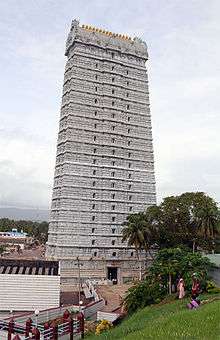 |
237[9][10] | 2008 CE | Murdeshwara Temple is known for its colossal, 40m high statue of Shiva. Its gopuram is the second tallest in India. It is also the only one where one can take a lift to top floor of the gopuram.[11] | Murdeshwar, Karnataka, India |
| 3 | Annamalaiyar Temple Eastern Gopuram (Raja Gopuram) |
 |
216.5[9] | 9th century CE | Annamalaiyar Temple covers 10 hectares, and is one of the largest temples in India. It is surrounded by four large unpainted gopurams, one facing each cardinal direction. The eastern gopuram rises to 66m, and is called the Raja Gopuram.[12] | Tiruvannamalai, Tamil Nadu, India |
| 4 | Srivilliputhur Andal Temple | .jpg) |
193.5[13] | 10th-16th centuries CE | Srivilliputhur Andal Temple's gopuram measures eleven storeys high and 59m tall, making it the tallest of its era. During the Madurai Nayak dynasty, lesser figures sponsored religious projects, including the large scale campus.[14] The temple is the emblem of the Government of Tamil Nadu.[13] | Srivilliputhur, Tamil Nadu, India |
| 5 | Ulagalantha Perumal Temple |  |
192 | CE | Ulagalantha Perumal Temple is dedicated to Trivikrama, the fifth incarnation of Vishnu. Its gopuram is 192 feet (59 m) in height. According to legends, The alvars Poigai Alvar, Bhoothathalvar and Peyalvar sang in praise of Vishnu at this temple, and their words later formed the integral part of the Nalayira Divya Prabandham.
One of the special features is that one idol contains the forms of two Gods - front side as Chakratalwar with sixteen hands and the back side as Narasimhar.[15] |
Tirukoilur, Tamil Nadu, India |
| 6 | Ekambareswarar Temple | .jpg) |
190[16] | CE | Ekambareswarar Temple is the largest temple in Kanchipuram, a highly visible symbol of Pallava dynasty. The entire complex covers an area of 10 hectares and has five courtyards.[17] | Kanchipuram, Tamil Nadu, India |
| 7 | Kallazhagar Temple | .jpg) |
187 | CE | Kallazhagar Temple is located in Azhagar Koyil, and is dedicated to Vishnu. In the outer gateway of the temple, there is a massive door that is rarely opened. The inner shrine is dedicated to Karupannaswamy, no image him is present. | Madurai, Tamil Nadu, India |
| 8 | Kasi Viswanathar temple, Tenkasi | 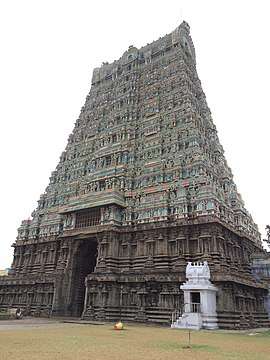 |
180 | 15th century CE | Built by the Pandya kings, the massive gopuram of the temple is the second largest in Tamil Nadu. It is also known as Ulagamman Temple. This temple boasts beautiful sculptures and also has musical stone pillars that produce different sounds when tapped with fingers. The name of the town (Tenkasi) is derived from this temple, meaning "Kasi of the south". The Chittar River nearby is consider sacred, similar to the Ganges. | Tenkasi, Tamil Nadu, India |
| 8 | Annamalaiyar Temple Northern Gopuram (Ammani Amman Gopuram) |
171[9] | 9th century CE | Annamalaiyar Temple covers 10 hectares, and is one of the largest temples in India. It is surrounded by four large unpainted gopurams, one facing each cardinal direction. The northern gopuram is called the Ammani Amman Gopuram.[12] | Tiruvannamalai, Tamil Nadu, India | |
| 9 | Meenakshi Amman Temple | 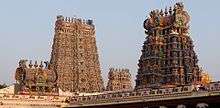 |
170 | 870 CE | Meenakshi Amman Temple houses 14 gopurams, ranging from 45m to 50m in height, the tallest being the southern tower at 51.9 metres (170 ft) high.[18] The temple has some very old sections but the largest part dates back to 17th century. The four gopuram are decorated with many figures from the Hindu pantheon and can be seen from great distances.[19] | Madurai, Tamil Nadu, India |
| 10 | Virupaksha Temple, main entrance gopuram | 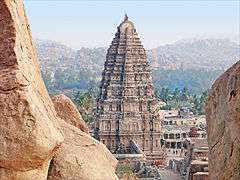 |
166 | 15th century CE | Virupaksha Temple was built during the time of Vijayanagara Empire. It is part of the Group of Monuments at Hampi, as a UNESCO World Heritage Site. | Hampi, Karnataka, India |
| 11 | Sarangapani Temple | 164 | 12th century CE | Sarangapani Temple is the largest Vishnu temple in Kumbakonam. The inner shrine is made in the form of a stone chariot, a common feature for temples built under the Chola kings.[20][21] | Kumbakonam, Tamil Nadu, India | |
| 12 | Annamalaiyar Temple Southern Gopuram (Tirumanjana Gopuram) |
157[9] | 9th century CE | Annamalaiyar Temple covers 10 hectares, and is one of the largest temples in India. It is surrounded by four large unpainted gopurams, one facing each cardinal direction. The southern gopuram is called the Tirumanjana Gopuram.[12] | Tiruvannamalai, Tamil Nadu, India | |
| 13 | Rajagopalaswamy Temple | 154 | 1523-1575 CE | Rajagopalaswamy Temple was started by Chola kings. Later, king Vijaya Raghava Nayak of the Vijayanagara Empire added the thousand pillar hall, the outer compound, and the large gopuram. Details of these constructions are recorded on inscriptions inside the temple.[22] | Mannargudi, Tamil Nadu, India | |
| 14 | Lakshmi Narasimha Temple, Mangalagiri | 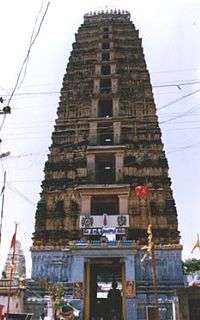 |
153[6][7] | 1809 CE[6] | Lakshmi Narasimha Temple is dedicated to Vishnu. Its gopuram is eleven storeys tall. Mangalagiri means "The Auspicious Hill". This temple is built on one of the eight important Mahakshetrams (sacred sites) in India[8] | Mangalagiri, Andhra Pradesh, India |
| 15 | Annamalaiyar Temple Northern Gopuram (Pei Gopuram) |
.jpg) |
144[9] | 9th century CE | Annamalaiyar Temple covers 10 hectares, and is one of the largest temples in India. It is surrounded by four large unpainted gopurams, one facing each cardinal direction. The northern gopuram is called the Pei Gopuram.[12] | Tiruvannamalai, Tamil Nadu, India |
| 16 | Ranganathaswamy Temple, Vellayi Gopuram |
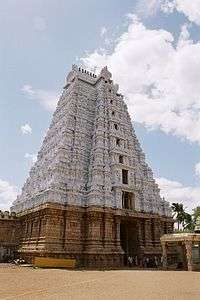 |
144 | [6] 13th Century CE [23] | Ranganathaswamy Temple one of the largest temple complexes in India, covering an area of 156 acres (63 ha).[8] It is home to twelve gopurams, the second largest being the Vellayi Gopuram. [24] | Srirangam, Tamil Nadu, India |
| 17 | Sankara Narayanan Temple, Sankaranayinarkoil, Sankarankovil | 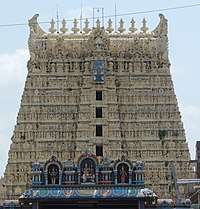 |
127 | 11th century CE | Sankara Narayanan Temple is located in the town of Sankaranayinarkoil, and is dedicated to both Shiva and Vishnu. | Sankarankovil, Tamil Nadu, India |
| 18 | Nanjundeshwara Temple | 120 | 9th century CE | Also known as Srikanteshwara Temple, dedicated to Shiva. | Nanjangud, Karnataka, India |
Tallest Vimana
Vimanas are structures over the sanctum of temples. In Northern India they are called sikharas.[5] In the Nagara style of architecture, the vimana is the sanctum (garbhagruha) of the temple housing the main deities and they are the tallest part of the entire temple. In many cases within South India, the vimanams are confused with gopurams. In Tamil Nadu, vimanams are present above the garbhagruha or sanctum sanctorum of a Hindu temple and will be relatively smaller in size compared to the gopurams, which are usually present at the entrance of the temple.
| Rank | Temple | Image | Height ft |
Year | Notes | Location |
|---|---|---|---|---|---|---|
| 1 | Chaturbhuj Temple | 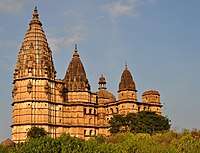 |
344 | 16th century CE | Built by the Bundela Rajputs of the Orchha State in Central India, the temple blends styles of both ancient Nagara architecture and new Mughal influences. The temple is dedicated to Rama and is the tallest temple structure in India. | Orchha, Madhya Pradesh, India |
| 2 | New Vishwanath Temple | 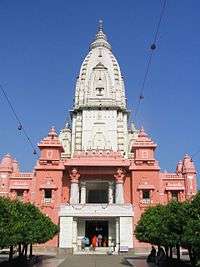 |
250[25] | 1966 | The Birla family undertook the construction and foundation was laid in March 1931. The temple (Shri Vishwanath Mandir) was finally completed in 1966. | Banaras Hindu University, Varanasi |
| 3 | Brihadeeswarar Temple | 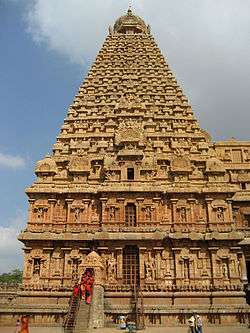 |
216[26][27] | 11th century CE | The Peruvudaiyar Koyil or Brihadeeswarar Temple, also known as Rajarajeswaram,[28] at Thanjavur in the Indian state of Tamil Nadu, is the world's first complete granite temple[29] and a brilliant example of the major heights achieved by Cholas kingdom Vishwakarmas in dravidian temple architecture. It is a tribute and a reflection of the power of its patron RajaRaja Chola I. It remains as one of the greatest glories of Indian architecture.[30] The temple is part of the UNESCO World Heritage Site "Great Living Chola Temples". | Thanjavur, Tamil Nadu, India |
| 4 | Jagannath Temple, Puri |  |
216[31] | 1174 C.E | The Jagannath Temple in Puri is a famous Hindu temple dedicated to Jagannath (Vishnu) and located in the coastal town of Puri in the state of Orissa, India. The name Jagannath (Lord of the Universe) is a combination of the Sanskrit words Jagat (Universe) and Nath (Lord of).[32]
The temple was built in the 11th century atop its ruins by the progenitor of the Eastern Ganga dynasty, King Anantavarman Chodaganga Deva. The temple is famous for its annual Rath Yatra, or chariot festival, in which the three main temple deities are hauled on huge and elaborately decorated temple cars. Since medieval times, it is also associated with intense religious fervour.[33] |
Puri, Odisha, India |
| 5 | Lingaraj Temple | 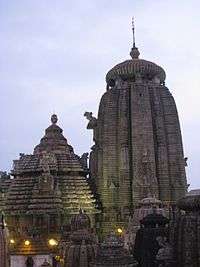 |
183.7[34] | 11th century CE | Lingaraja Temple is a temple of the Hindu god Harihara and is one of the oldest temples of the Temple City Bhubaneswar, a revered pilgrimage center and the capital of the state of Orissa. The temple of Lingaraja, the biggest of all at Bhubaneswar is located within a spacious compound wall of laterite measuring 520 feet by 465 feet. The wall is 7 feet 6 inches thick and surmounted by a plain slant coping. Alongside the inner face of the boundary wall there runs a terrace probably meant to protect the compound wall against outside aggression.[35] | Bhubaneshwar, Odisha, India |
| 6 | Brihadisvara temple, Gangankonda Cholapuram, Tamil Nadu | 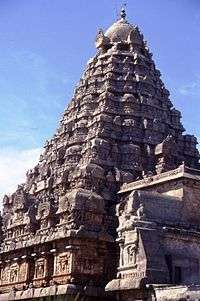 |
182[36] | 11th century CE | The Vimana with its recessed corners and upward movement presents a striking contrast to the straight-sided pyramidal tower of Thanjavur but with octagon shape of Dravidian architecture. As it rises to a height of 182 feet (55 m) and is shorter than the Thanjavur tower with larger plinth, it is often described as the feminine counterpart of the Thanjavur temple.
The Vimana is flanked on either side by small temples; the one in the north now housing the Goddess is fairly well preserved. The small shrine of Chandikesvara is near the steps in the north. In the north-east are a shire housing Durga, a well called lion-well (simhakeni) with a lion figure guarding its steps and a late mandapa housing the office. Nandi is in the east facing the main shrine. In the same direction is the ruined gopura, the entrance tower. The main tower surrounded by little shrines truly presents the appearance of a great Chakravarti (emperor) surrounded by chieftains and vassals. The Gangaikondacholapuram Vimana is undoubtedly a devalaya chakravarti, an emperor among temples of South India.[37] |
Gangaikonda Cholapuram, Tamil Nadu, India |
| 7 | Somnath Temple | .jpg) |
155 | 1951 | Prabhas Patan, Gujarat, India | |
| 8 | Konark Sun Temple | 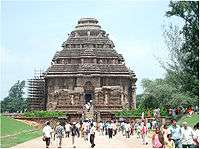 |
130[38] 230 before ruin[39] | 13th century CE | Konark Sun Temple (also known as the Black Pagoda), was built in black granite by King Narasimhadeva I (1236 C.E-1264 C.E) of the Eastern Ganga Dynasty. The temple is a UNESCO World Heritage Site. Built in the 13th century, the temple is designed in the shape of a colossal chariot with 24 wheels (3.3 m dia diameter each) drawn by seven horses and, carrying the Sun god, Surya, across the heavens. It is a stunning monument of religious (Brahmanical) Kalinga architecture. The large structure seen today is actually the mantapa (mandap). Of the main tower, which once stood in the front, only the remains can be seen. This tower (deul) was perhaps 230 feet (70 meters) tall, higher than any other temple in India. | Konark, Odisha, India |
Notes
- Ching, Francis D.K.; et al. (2007). A Global History of Architecture. New York: John Wiley and Sons. p. 762. ISBN 0-471-26892-5.
- Ching, Francis D.K. (1995). A Visual Dictionary of Architecture. New York: John Wiley and Sons. p. 253. ISBN 0-471-28451-3.
- Mitchell, George (1988). The Hindu Temple. Chicago: University of Chicago Press. pp. 151–153. ISBN 0-226-53230-5.
- "gopura". Encyclopædia Britannica. Retrieved 2008-01-20.
- 108 Vaishnavite Divya Desams: Divya desams in Pandya Nadu. M. S. Ramesh, Tirumalai-Tirupati Devasthanam.
- Chand 1987, p. 36
- A new Rajagopuram Frontline Magazine, 4–17 April 1987.
- Yatra2Yatra. Sanjay Singh.
- Singh 2009, p. 1069
- Daiji World, 14 April 2008.
- South India P.271. Sarina Singh
- South India P. 418. Sarina Singh
- Tourist guide to Tamil Nadu 2007, p. 109
- Architecture and art of southern India: Vijayanagara and Successor States, Volume 1, Issue 6P.112. George Michell
- http://www.indian-heritage.org/temple/tirukoil.htm
- Sajnani 2001, pp. 305
- India P.545. Karen Schreitmüller
- Sajnani 2001, pp. 307-308
- India P.586. Karen Schreitmüller
- South India P.432. Sarina Singh
- Temples of South India P.112. V.V. Subba Reddy
- Power of Passion P. 4. S. Manickavasagam
- https://en.wikipedia.org/wiki/Ranganathaswamy_Temple,_Srirangam#Gopurams
- https://www.thehindu.com/news/cities/Tiruchirapalli/the-legend-of-vellayi/article2774700.ece
- "Vishwanath Mandir, BHU".
- Middle Chola Temples, S.R. Balasubrahmanyam
- CBSE textbook on Social Studies Class 10
- South Indian Inscriptions - VolII, Part I& II
- http://india.gov.in/myindia/facts.php
- Atlas of the Year 1000 - Page 105 by John Man
- The Jagannatha Temple at Puri: its architecture, art, and cult.O. M. Starza
- Vedic Concepts "An example in Sanskrit is seen with the word Jagat which means universe.] |accessdate=2006-09-12
- "Jagannath Temple History". Time. 1959-07-20.
- Land and people of Indian states and union territories: in 36 volumes. Orissa .S. C. Bhatt, Gopal K. Bhargava
- Ramesh Prasad Mohapatra (1986) Page 69. Archaeology in Orissa Vol I. B. R. Publishers, Delhi ISBN 81-7018-346-4
- Nagasamy R, Rajapalayam (1970), State Department of Archaeology, Government of Tamil Nadu
- "Gangankonda Cholapuram Temple History". Time. 1959-07-20.
- "Archived copy". Archived from the original on 2012-05-09. Retrieved 2011-11-08.CS1 maint: archived copy as title (link)
- http://konark.nic.in/maintemple.htm
References
- Chand, Attar (1987), The great humanist Ramaswami Venkataraman, Delhi: Gian Publishing House, ISBN 81-212-0106-3.
- Sajnani, Dr. Manohar (2001), Encyclopedia of tourism resources in India, Volume 2, Delhi: Kalpaz Publications, ISBN 81-7835-014-9.
- Singh, Sarina; Lindsay Brown; Mark Elliott; Paul Harding; Abigail Hole; Patrick Horton (2009), Lonely Planet India, Australia: Lonely Planet.
- Tourist guide to Tamil Nadu (2007), Tourist guide to Tamil Nadu, Chennai: T. Krishna Press, ISBN 81-7478-177-3.